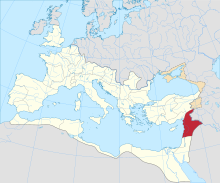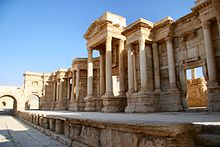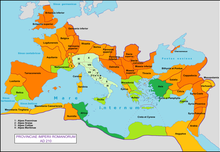Roman Syria
You can help expand this article with text translated from the corresponding article in Italian. (February 2024) Click [show] for important translation instructions.
|
| Provincia Syria ἐπαρχία Συρίας eparchía Syrías | |||||||||||||||
|---|---|---|---|---|---|---|---|---|---|---|---|---|---|---|---|
| Province of the Roman Empire | |||||||||||||||
| 64 BC–198 AD | |||||||||||||||
 Roman Syria highlighted in 125 AD | |||||||||||||||
| Capital | Antioch (modern-day Antakya, Hatay, Turkey) | ||||||||||||||
| History | |||||||||||||||
• Conquest of Coele-Syria by Pompey | 64 BC | ||||||||||||||
• Province divided into Coele Syria and Phoenice | 198 AD | ||||||||||||||
| |||||||||||||||
| Today part of | |||||||||||||||
Roman Syria was an early Roman province annexed to the Roman Republic in 64 BC by Pompey in the Third Mithridatic War following the defeat of King of Armenia Tigranes the Great, who had become the protector of the Hellenistic kingdom of Syria.[1]
Following the partition of the
Provincia Syria

Syria was
Following the
In 6 AD, Emperor
were also transferred under the jurisdiction of the province of Syria.From 37 to 41 AD, much of the southern region was separated from Syria and transformed into a
Syrian province forces were directly engaged in the
Based on an inscription recovered from
As related by Theodor Mommsen,
The governor of Syria retained the civil administration of the whole large province undiminished, and held for long alone in all Asia a command of the first rank. [...] It was only in the course of the second century that a diminution of his prerogatives occurred, when Hadrian took one of the four legions from the governor of Syria and handed it over to the governor of Palestine.[4]
Aftermath
Division into Coele Syria and Syria Phoenice
| Provincia Coele Syria ἐπαρχία Κοίλης Συρίας | |||||||||||
|---|---|---|---|---|---|---|---|---|---|---|---|
| Province of the Roman Empire | |||||||||||
| 198–end of 4th century | |||||||||||
 Roman Empire in 210 | |||||||||||
| Capital | Antioch | ||||||||||
| History | |||||||||||
• Established | 198 | ||||||||||
• Disestablished | end of 4th century | ||||||||||
| |||||||||||
| Today part of | |||||||||||
| Provincia Syria Phoenice | |||||||||||||
|---|---|---|---|---|---|---|---|---|---|---|---|---|---|
| Province of the Roman Empire | |||||||||||||
| 198–end of 4th century | |||||||||||||
 Roman Empire in 210 | |||||||||||||
| Capital | Tyre | ||||||||||||
| History | |||||||||||||
• Established | 198 | ||||||||||||
• Disestablished | end of 4th century | ||||||||||||
| |||||||||||||
As related by Theodor Mommsen,
It was
Syro-Phoenicia, one [legion].[4]
From the later 2nd century, the
Syria was of crucial strategic importance during the Crisis of the Third Century. In 244 AD, Rome was ruled by a native Syrian from Philippopolis (modern day Shahba) in the province of Arabia Petraea. The emperor was Marcus Iulius Philippus, more commonly known as Philip the Arab. Philip became the 33rd emperor of Rome upon its millennial celebration.
Roman Syria was invaded in 252/253 (the date is disputed) after a Roman field army was destroyed in the Battle of Barbalissos by the King of Persia Shapur I which left the Euphrates river unguarded and the region was pillaged by the Persians. In 259/260 a similar event happened when Shapur I again defeated a Roman field army and captured the Roman emperor, Valerian, alive at the Battle of Edessa. Again, Roman Syria suffered as cities were captured, sacked and pillaged.
From 268 to 273, Syria was part of the breakaway Palmyrene Empire.
| The 'Orient' in the time of Septimius Severus c. 200 AD[7] | ||
|---|---|---|
| Coele Syria | Provincia Syria Coele | |
| Phoenicia | Provincia Syria Phoenice | |
| Palaestina | Provincia Syria Palaestina | |
| Arabia | Provincia Arabia Petraea | |
Dominate reform
Following the reforms of
Syria in the Byzantine Empire

After c. 415, Syria Coele was further subdivided into Syria I (or

The region remained one of the most important provinces of the
The city ofDemographics
Provinicia Syria had a diverse demographic distribution. The rural inland was mostly populated by
On the other hand, Greeks comprised a majority in Hellenistic urban centers such Antioch, Apamea, Cyrrhus and the Decapolis, which had been settled by Greeks under Seleucid patronage.[13]
Estimates for the population of the entire Levant in the 1st century vary from 3.5–4 million to 6 million, levels only matched even by 19th century levels. Urban centers peaked and so did population density in the rural settlements. Antioch and Palmyra reached a peak of 200,000–250,000 inhabitants, while Apamea counted 117,000 'free citizens' circa AD 6. Combined with their dependancies and villages, Apamea and Cyrrhus may have counted as high as 500,000 each. The Syrian Coastal Mountain Range, marginal hill country, were less densely settled and had a population of around 40–50,000.[14]
Identity
The inhabitants of Syria adopted
In contrast to Jews, who shared collective historical memories, Syrians lacked a unified cultural or social identity. The unifying aspects in Roman Syria were Greek civic structures and narratives promoted by Roman imperial rule, suggesting that Syrian culture was largely defined through Greek and Roman influences. The term 'Syrian' therefore primarily functioned as a geographical designation.[15]
Episcopal sees
Ancient episcopal sees of the late Roman province of Syria Prima (I) listed in the Annuario Pontificio as titular sees:[16]
- Anasartha(Khanasir)
- Barcusus (Baquza or Banqusa)
- Beroea (Aleppo)
- Chalcis in Syria(Qinnasrin)
- Gabala (Jableh)
- Gabula (at the marsh of Al-Jabbul)
- Gindarus(Jandairis)
- Laodicea in Syria (Latakia)
- Salamias(Salamiyah)
- Seleucia Pieria
Ancient episcopal sees of the late Roman province of Syria Secunda (II) listed in the Annuario Pontificio as titular sees:[16]
- Apamea in Syria, the Metropolitan Archdiocese
- Arethusa (Al-Rastan)
- Balanea(Baniyas)
- Epiphania in Syria (Hama)
- Larissa in Syria(Shaizar)
- Mariamme (Maryamin)
- Raphanea
- Seleucobelus(Seleucopolis)
See also
- History of Syria
- Ottoman Syria
- Assyria (Roman province)
- List of governors of Roman Syria
References
- ISBN 978-0-275-97140-3.
- ^ Dov Gera and Hannah M. Cotton, "A Dedication from Dor to a Governor of Syria", Israel Exploration Journal, 41 (1991), pp. 258–66
- ^ Divers Find Unexpected Roman Inscription From the Eve of Bar-Kochba Revolt Haaretz.com (Last accessed 6 June 2017)
- ^ a b Mommsen 1886, pp. 117–118.
- ^ Marquardt 1892, p. 373: "Tandis que la Judée ou Syria Palaestina demeurait ainsi séparée de la Syrie depuis l'an 66 après J.-C., la Syrie elle-même fut plus tard divisée en deux provinces : la Syria magna ou Syria Coele, et la Syria Phoenice".
- ^ Adkins & Adkins 1998, p. 121: "Septimius Severus divided the remaining province into Syria Coele and Syria Phoenice".
- ISBN 978-0-520-93102-2.
In 194 A.D. The emperor Septimus Severus divided the province of Syria and made the northern part into a separate province called Coele Syria.
- ^ ISBN 978-0-19-504652-6.
- ISBN 978-0-19-504652-6.
- ISBN 978-0-86078-992-5.
- ISBN 978-0-520-34041-1.
- ISBN 978-0-472-08315-2.
- ISBN 9780520931022.
- ^ Kennedy, David L. "Demography, the Population of Syria and the Census of Q. Aemilius Secundus". Academia.
- ^ ISBN 978-0-511-99780-8, retrieved 2024-02-04
- ^ ISBN 978-88-209-9070-1), "Sedi titolari", pp. 819-1013
Sources
- Adkins, Lesley; Adkins, Roy A. (1998). Handbook to Life in Ancient Rome. ISBN 978-0-19-512332-6.
- Marquardt, Joachim (1892). L'organisation de l'Empire romain.
- Mommsen, Theodor (1886). The History of Rome. R. Bentley.
External links
- Bagnall, R., J. Drinkwater, A. Esmonde-Cleary, W. Harris, R. Knapp, S. Mitchell, S. Parker, C. Wells, J. Wilkes, R. Talbert, M. E. Downs, M. Joann McDaniel, B. Z. Lund, T. Elliott, S. Gillies (30 January 2018). "Places: 981550 (Syria)". Pleiades. Retrieved March 8, 2012.
{{cite web}}: CS1 maint: multiple names: authors list (link)
